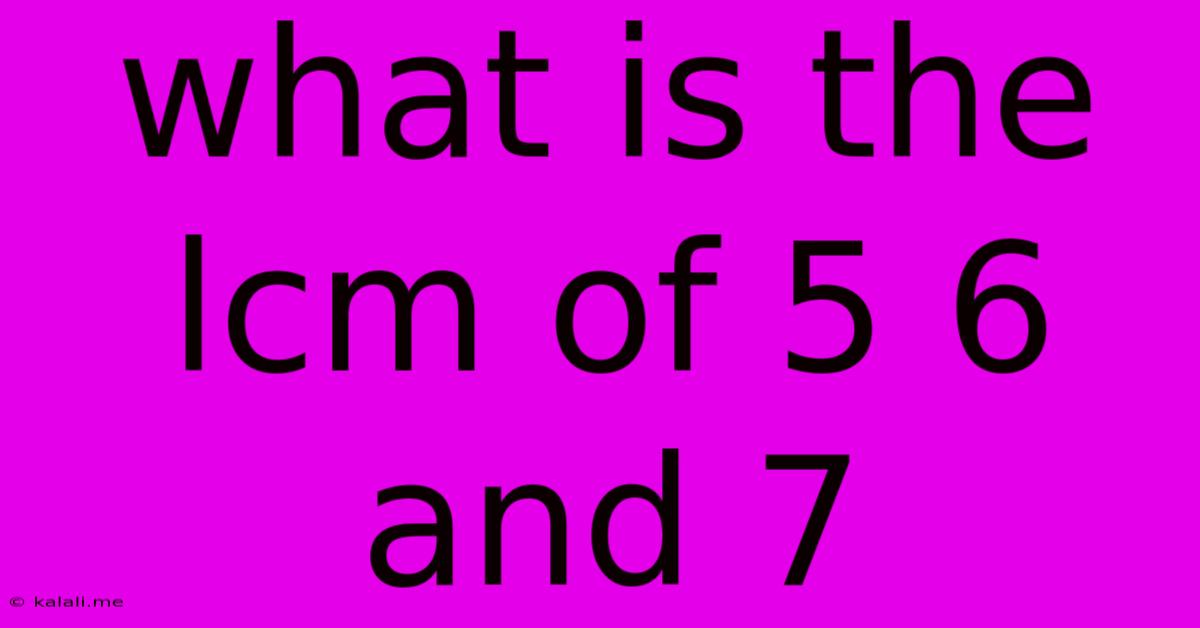What Is The Lcm Of 5 6 And 7
Kalali
Jun 14, 2025 · 3 min read

Table of Contents
What is the LCM of 5, 6, and 7? Finding the Least Common Multiple
Finding the least common multiple (LCM) of a set of numbers is a fundamental concept in mathematics, frequently used in various fields like fractions, scheduling, and even music theory. This article will guide you through calculating the LCM of 5, 6, and 7, explaining the process step-by-step and providing helpful tips for tackling similar problems. Understanding this process will improve your math skills and broaden your understanding of number theory.
The least common multiple (LCM) is the smallest positive integer that is divisible by all the numbers in a given set. In simpler terms, it's the smallest number that all the numbers in your set can divide into evenly. Let's find the LCM of 5, 6, and 7.
Method 1: Prime Factorization
This method is generally considered the most efficient way to find the LCM of larger numbers. It involves breaking down each number into its prime factors.
-
Find the prime factorization of each number:
- 5 = 5 (5 is a prime number)
- 6 = 2 x 3 (Both 2 and 3 are prime numbers)
- 7 = 7 (7 is a prime number)
-
Identify the highest power of each prime factor:
- The prime factors present are 2, 3, 5, and 7.
- The highest power of 2 is 2¹ = 2
- The highest power of 3 is 3¹ = 3
- The highest power of 5 is 5¹ = 5
- The highest power of 7 is 7¹ = 7
-
Multiply the highest powers together:
- LCM(5, 6, 7) = 2 x 3 x 5 x 7 = 210
Therefore, the least common multiple of 5, 6, and 7 is 210.
Method 2: Listing Multiples (Suitable for smaller numbers)
This method involves listing the multiples of each number until you find the smallest multiple common to all. While effective for smaller numbers, it becomes less practical for larger sets or larger numbers.
-
List the multiples of each number:
- Multiples of 5: 5, 10, 15, 20, 25, 30, 35, 40, 45, 50, 55, 60, 65, 70, 75, 80, 85, 90, 95, 100, 105, 110, 115, 120, 125, 130, 135, 140, 145, 150, 155, 160, 165, 170, 175, 180, 185, 190, 195, 200, 205, 210...
- Multiples of 6: 6, 12, 18, 24, 30, 36, 42, 48, 54, 60, 66, 72, 78, 84, 90, 96, 102, 108, 114, 120, 126, 132, 138, 144, 150, 156, 162, 168, 174, 180, 186, 192, 198, 204, 210...
- Multiples of 7: 7, 14, 21, 28, 35, 42, 49, 56, 63, 70, 77, 84, 91, 98, 105, 112, 119, 126, 133, 140, 147, 154, 161, 168, 175, 182, 189, 196, 203, 210...
-
Find the smallest common multiple: The smallest number that appears in all three lists is 210.
Therefore, using this method also confirms that the LCM of 5, 6, and 7 is 210.
Conclusion
The prime factorization method is generally preferred for its efficiency, especially when dealing with larger numbers. However, the listing multiples method provides a clear visual understanding of the concept for beginners. Regardless of the method used, the LCM of 5, 6, and 7 is definitively 210. Remember this process; it's a valuable tool in your mathematical arsenal.
Latest Posts
Latest Posts
-
Find Moment Of Inertia Of Solid Sphere
Jun 15, 2025
-
Difference Between Production And Operations Management
Jun 15, 2025
-
Which Of The Following Is A Weak Acid
Jun 15, 2025
-
Classify The Statements About Greenhouse Gases As True Or False
Jun 15, 2025
-
University Of Hawaii Acceptance Rate Out Of State
Jun 15, 2025
Related Post
Thank you for visiting our website which covers about What Is The Lcm Of 5 6 And 7 . We hope the information provided has been useful to you. Feel free to contact us if you have any questions or need further assistance. See you next time and don't miss to bookmark.